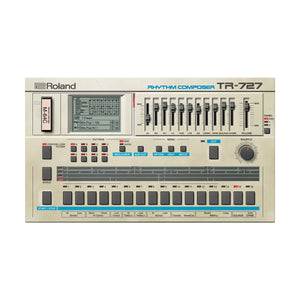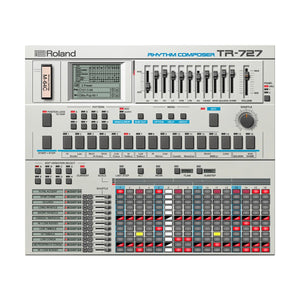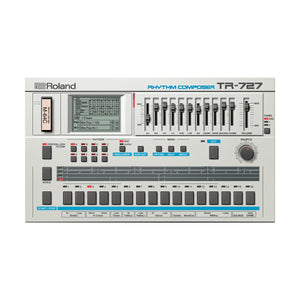Your Cart is Empty



Get back in the groove.
In 1985 Roland released the TR-727 Rhythm Composer—the Latin percussion packed sibling of the now-famous TR-707. Lesser known but no less loved, the TR-727 found its way into a wide range of styles over the decades, from tribal and acid house to pop and techno. And it’s perfect for afrobeat, reggaeton, and other more exotic contemporary styles. Thanks to our Analog Circuit Behavior (ACB) technology, you can now have the authentic sound and experience of this classic percussion machine right inside your DAW— with modern upgrades that make it into all-new territory.
Features
-
Analog Circuit Behavior technology captures every detail of the original hardware
-
Uses the original TR-727 sample ROM
-
Includes all 15 original sounds and 64 original patterns
-
43 new patterns and kits for modern styles
-
Get modern sounds with tuning, decay, gain, sample rate adjustment, and more
-
Powerful sequencer with flams, sub-steps, last step, and per-instrument shuffle
-
Drag and drop audio or MIDI patterns directly to DAW tracks or cells
-
Original and aged skins along with LCD-style sequencer windows
-
Multiple outputs for flexible effects processing with plugins like ZENOLOGY FX
-
VST3, AU, and AAX support for popular DAWs
-
Native support for Apple silicon
Specifications
-
Maximum Polyphony
11 voices
-
Sampling Frequency
44.1 kHz, 48 kHz, 88.2 kHz, 96 kHz, 176.4 kHz, 192 kHz
-
Step Sequencer
11 instrument parts
16 steps per 1 measure
8 (A - H) variations per 1 pattern
-
INST tone
BONGO (HI/LOW)
HI CONGA (MUTE/OPEN)
LOW CONGA
HI TIMBALE
LOW TIMBALE
AGOGO (HI/LOW)
CABASA/MARACAS
SHORT WHISTLE
LONG WHISTLE
QUIJADA
STAR CHIME
*Slashed instruments are selectable.
-
Memories per bank
128 patterns
128 memories
* User can make new user banks.
-
Plug-In Formats
VSTi 3.6 (64 bit)
AU
AAX
-
System Requirments Mac OS
-
Operating System
macOS 10.14
macOS 10.15
macOS 11
-
Host Application
VST instruments (VSTi) version: VST 3.6 compatible
Audio Units (AU) version: V2 Audio Units are compatible
AAX Compatible
-
CPU
Intel(R) Core(TM) i5 or better
Apple M1 Chip
-
RAM
2 GB or more
-
Hard Disk
400 MB or more
-
Display resolution and Colors
1,280 x 800 dots or higher, 16.7 million colors or more
-
Other
You'll need Internet connectivity to Authenticate this software.
System Requirements Windows
-
Microsoft(R) Windows(R) 10 (64-bit)
This does not work with the Windows(R) RT.
This does not work with the Windows(R) Phone.
This does not work on virtual machines such as Hyper-V, Virtual PC, or Boot Camp.
-
Host Application
VST instruments (VSTi) version: VST 3.6 compatible
AAX Compatible
-
CPU
Intel(R) Core(TM) i5 or better
-
RAM
2 GB or more
-
Hard Disk
400 MB or more
-
Display resolution and Colors
1,280 x 800 dots or higher, 24 bits Full Color or more
-
Other
You'll need Internet connectivity to Authenticate this software.
-
* Although Roland has tested numerous configurations, and has determined that on average, a computer system similar to that described above will permit normal operation of the TR-727 Software Rhythm Composer, Roland cannot guarantee that a given computer can be used satisfactorily with the TR-727 Software Rhythm Composer based solely on the fact that it meets the above requirements. This is because there are too many other variables that may influence the processing environment, including differences in motherboard design and the particular combination of other devices involved.



